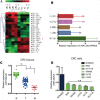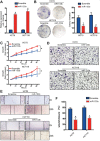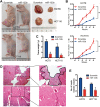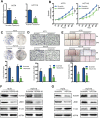miR-133b suppresses metastasis by targeting HOXA9 in human colorectal cancer
- PMID: 28969042
- PMCID: PMC5609974
- DOI: 10.18632/oncotarget.19212
miR-133b suppresses metastasis by targeting HOXA9 in human colorectal cancer
Abstract
Functions and mechanisms of microRNA (miRNA) involved in colorectal cancer (CRC) metastasis are largely unknown. Here, a miRNA microarray analysis was performed in CRC primary tissues and metastatic hepatic tissues to disclose crucial miRNA involved in CRC metastasis. MiR-133b was decreased and negatively correlated with metastasis in CRC. Overexpression of miR-133b significantly suppressed metastasis of CRC in vitro and in vivo. HOXA9 was identified as a direct and functional target of miR-133b. In addition, HOXA9 was negatively correlated with miR-133b and promoted CRC malignant progress. Moreover, miR-133b decreased HOXA9 expression, and subsequently downregulated ZEB1 and upregulated E-cadherin expression. Intriguingly, lower miR-133b and higher HOXA9 expression significantly contributed to poorer outcomes in CRC patients. Multivariate analysis indicated that miR-133b was an independent and significant predictor of CRC patient overall survival. In conclusion, we newly determined that miR-133b targeted the HOXA9/ZEB1 pathway to promote tumor metastasis in CRC cells. This axis provided insights into the mechanism underlying miRNA regulation of CRC metastasis and a novel therapeutic target for CRC treatment.
Keywords: HOXA9; colorectal cancer; metastasis; miR-133b.
Conflict of interest statement
CONFLICTS OF INTEREST There are no potential conflicts of interest with regard to this paper.
Figures







Similar articles
-
miR-192, a prognostic indicator, targets the SLC39A6/SNAIL pathway to reduce tumor metastasis in human hepatocellular carcinoma.Oncotarget. 2016 Jan 19;7(3):2672-83. doi: 10.18632/oncotarget.6603. Oncotarget. 2016. PMID: 26684241 Free PMC article.
-
MicroRNA-133b is regulated by TAp63 while no gene mutation is present in colorectal cancer.Oncol Rep. 2017 Mar;37(3):1646-1652. doi: 10.3892/or.2017.5371. Epub 2017 Jan 16. Oncol Rep. 2017. PMID: 28098895
-
DNA methylation is involved in the aberrant expression of miR-133b in colorectal cancer cells.Oncol Lett. 2015 Aug;10(2):907-912. doi: 10.3892/ol.2015.3336. Epub 2015 Jun 8. Oncol Lett. 2015. PMID: 26622593 Free PMC article.
-
Serum miR-133b is a potential novel prognostic biomarker for colorectal cancer.Int J Clin Exp Pathol. 2017 Dec 1;10(12):11673-11678. eCollection 2017. Int J Clin Exp Pathol. 2017. PMID: 31966526 Free PMC article.
-
miR-133b, a particular member of myomiRs, coming into playing its unique pathological role in human cancer.Oncotarget. 2017 Jul 25;8(30):50193-50208. doi: 10.18632/oncotarget.16745. Oncotarget. 2017. PMID: 28422730 Free PMC article. Review.
Cited by
-
lncRNA MIR503HG inhibits cell proliferation and promotes apoptosis in TNBC cells via the miR-224-5p/HOXA9 axis.Mol Ther Oncolytics. 2021 Mar 17;21:62-73. doi: 10.1016/j.omto.2021.03.009. eCollection 2021 Jun 25. Mol Ther Oncolytics. 2021. PMID: 33869743 Free PMC article.
-
miR-652 Promotes Proliferation and Migration of Uveal Melanoma Cells by Targeting HOXA9.Med Sci Monit. 2019 Nov 19;25:8722-8732. doi: 10.12659/MSM.917099. Med Sci Monit. 2019. PMID: 31740654 Free PMC article.
-
HOXA9 transcription factor is a double-edged sword: from development to cancer progression.Cancer Metastasis Rev. 2024 Jun;43(2):709-728. doi: 10.1007/s10555-023-10159-2. Epub 2023 Dec 8. Cancer Metastasis Rev. 2024. PMID: 38062297 Free PMC article. Review.
-
Integrated analysis of colorectal cancer microRNA datasets: identification of microRNAs associated with tumor development.Aging (Albany NY). 2018 May 18;10(5):1000-1014. doi: 10.18632/aging.101444. Aging (Albany NY). 2018. PMID: 29779016 Free PMC article.
-
Identification of MicroRNAs Regulating Clostridium perfringens Type C Infection in the Spleen of Diarrheic Piglets.Curr Issues Mol Biol. 2023 Apr 6;45(4):3193-3207. doi: 10.3390/cimb45040208. Curr Issues Mol Biol. 2023. PMID: 37185732 Free PMC article.
References
-
- Torre LA, Bray F, Siegel RL, Ferlay J, Lortet-Tieulent J, Jemal A. Global cancer statistics, 2012. CA Cancer J Clin. 2015;65:87–108. - PubMed
-
- Siegel RL, Miller KD, Jemal A. Cancer statistics, 2016. CA Cancer J Clin. 2016;66:7–30. - PubMed
-
- Sato H, Kotake K, Sugihara K, Takahashi H, Maeda K, Uyama I, Study Group for Peritoneal Metastasis from Colorectal Cancer By the Japanese Society for Cancer of the C and Rectum Clinicopathological factors associated with recurrence and prognosis after R0 resection for stage IV colorectal cancer with peritoneal metastasis. Dig Surg. 2016;33:382–391. - PubMed
-
- Mohammadi M, Kaghazian M, Rahmani O, Ahmadi K, Hatami E, Ziari K, Talebreza A. Overexpression of interleukins IL-17 and IL-8 with poor prognosis in colorectal cancer induces metastasis. Tumour Biol. 2016;37:7501–7505. - PubMed
LinkOut - more resources
Full Text Sources
Other Literature Sources

